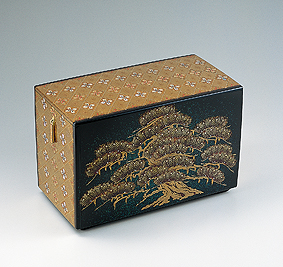Small Cabinet "Fresh Pine"
H 19.1 x W 15.8 x D 29.8 cm,Year.2006Kazumi Murose
1950 -- LacquerwareLiving National Treasure
-
Price Range
$13,000 - 195,000
Info
The prices of the artworks on Gallery Japan are determined by the artists themselves and are published directly on the website.
close
About the Artwork
"Maki-e is a technique in which designs drawn in urushi(lacquer) are sprinkled with gold powder before they harden. The artist, specializes in this technique togidashi (polished back) maki-e, which is one of its basic varieties, and the oldest, carried out continuously since the ninth century.
Please look closely at the trunk of the old pine tree depicted on the side of this work. In order to recreate the texture of the tree, the artist grated lumps of gold and used the resultant dust in a traditional manner. As the dust is neither not arranged nor processed, each grain is accentuated, superbly conveying the feel of the tree’s rugged bark. It took approximately two years to complete the work, which is also notable for its use of sprinkled gold powder and the iridescent parts of seashells."
Description
-
CategoryLacquerware
-
DimensionsH 19.1 x W 15.8 x D 29.8 cm
-
Year presented2006
-
RarityUnique
Techniques Used
Dry lacquer
For works of dry lacquer (kanshitsu), first a clay form is created and plaster is used to take a mold of the form. Next, repeated layers of hemp cloth and lacquer are applied to the mold until they are built up to the desired thickness. Finally, the mold is removed and additional coats of lacquer are applied to finish the piece. The hemp fibers are strengthened when the lacquer bonds with them, making dry lacquer an excellent technique for creating sturdy forms with a significant degree of freedom.
Maki-e
Maki-e (literally “sprinkled pictures”) is a representative lacquerware technique that originated in Japan around 1,200 years ago. Maki-e is done by painting lacquer motifs on the surface of a piece using a fine brush and then sprinkling gold powder onto the lacquer before it hardens, producing luxurious decorations.
Mother-of-pearl inlay (Raden)
Mother-of-pearl inlay (Raden) is a decorative technique that uses the iridescent inner layer of abalone shell, turban shell, pearl oyster shell, or other mollusk shells. The technique came to Japan from China 1,300 years ago, and pieces featuring mother-of-pearl inlay are included among the artifacts at the Shōsōin Repository in Nara.
Selected exhibitions
- The 53rd Japan Traditional Kōgei Exhibition (2006)
- Selected
Please feel free to contact us to commission work, check artworks available for purchase etc.

